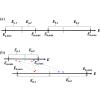当前位置:
X-MOL 学术
›
Phys. Rev. B
›
论文详情
Our official English website, www.x-mol.net, welcomes your feedback! (Note: you will need to create a separate account there.)
Complex-time shredded propagator method for large-scaleGWcalculations
Physical Review B ( IF 3.7 ) Pub Date : 2020-01-23 , DOI: 10.1103/physrevb.101.035139 Minjung Kim , Glenn J. Martyna , Sohrab Ismail-Beigi
Physical Review B ( IF 3.7 ) Pub Date : 2020-01-23 , DOI: 10.1103/physrevb.101.035139 Minjung Kim , Glenn J. Martyna , Sohrab Ismail-Beigi

|
The method is a many-body electronic structure technique capable of generating accurate quasiparticle properties for realistic systems spanning physics, chemistry, and materials science. Despite its power, is not routinely applied to study large complex assemblies due to the method's high computational overhead and quartic scaling with particle number. Here, the equations are recast, exactly, as Fourier-Laplace time integrals over complex time propagators. The propagators are then “shredded” via energy partitioning and the time integrals approximated in a controlled manner using generalized Gaussian quadrature(s) while discrete variable methods are employed to represent the required propagators in real space. The resulting cubic scaling method has a sufficiently small prefactor to outperform standard quartic scaling methods on small systems ( atoms) and offers 2–3 order of magnitude improvement in large systems ( atoms). It also represents a substantial improvement over other cubic methods tested for all system sizes studied. The approach can be applied to any theoretical framework containing large sums of terms with energy differences in the denominator.
中文翻译:

用于大规模GW计算的复杂时间切丝繁殖器方法
的 方法是一种多体电子结构技术,能够为涵盖物理,化学和材料科学的现实系统生成准确的准粒子属性。尽管有力量,由于该方法的高计算开销和带有粒子数的四次缩放,因此没有常规应用于研究大型复杂组件。在这里方程被精确地重现为复杂时间传播子上的傅立叶-拉普拉斯时间积分。然后,通过能量分配对传播器进行“粉碎”,并使用广义的高斯积分以受控方式对时间积分进行近似,同时采用离散变量方法来表示实际空间中所需的传播器。产生的立方缩放 方法具有足够小的前置因子,可以胜过小型系统上的标准四次缩放方法( 原子),并在大型系统中提供2-3个数量级的改进(原子)。对于所有研究的系统尺寸,它也比其他立方方法进行了重大改进。该方法可以应用于任何包含大量在分母中具有能量差异的项的理论框架。
更新日期:2020-01-23
中文翻译:

用于大规模GW计算的复杂时间切丝繁殖器方法
的 方法是一种多体电子结构技术,能够为涵盖物理,化学和材料科学的现实系统生成准确的准粒子属性。尽管有力量,由于该方法的高计算开销和带有粒子数的四次缩放,因此没有常规应用于研究大型复杂组件。在这里方程被精确地重现为复杂时间传播子上的傅立叶-拉普拉斯时间积分。然后,通过能量分配对传播器进行“粉碎”,并使用广义的高斯积分以受控方式对时间积分进行近似,同时采用离散变量方法来表示实际空间中所需的传播器。产生的立方缩放 方法具有足够小的前置因子,可以胜过小型系统上的标准四次缩放方法( 原子),并在大型系统中提供2-3个数量级的改进(原子)。对于所有研究的系统尺寸,它也比其他立方方法进行了重大改进。该方法可以应用于任何包含大量在分母中具有能量差异的项的理论框架。



























 京公网安备 11010802027423号
京公网安备 11010802027423号